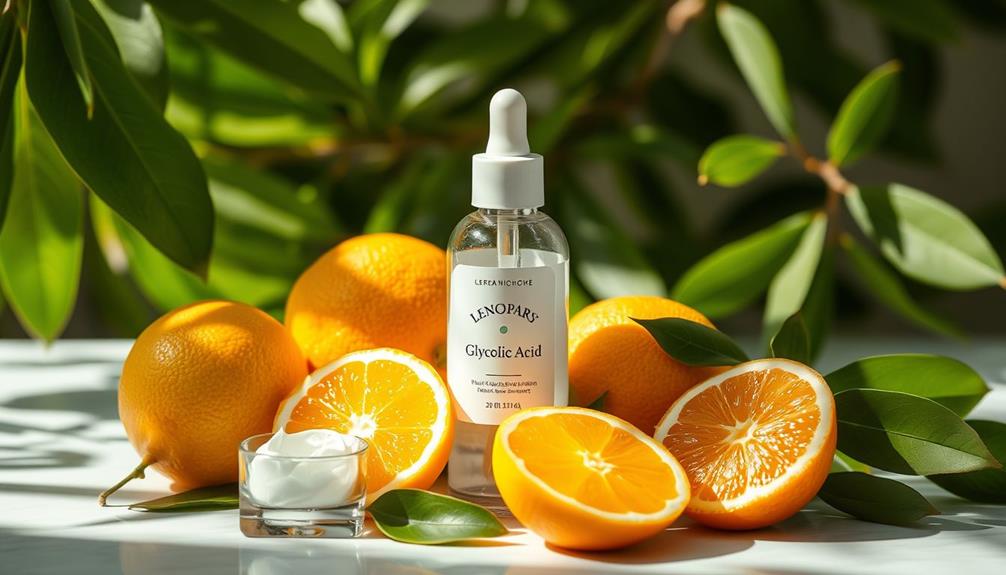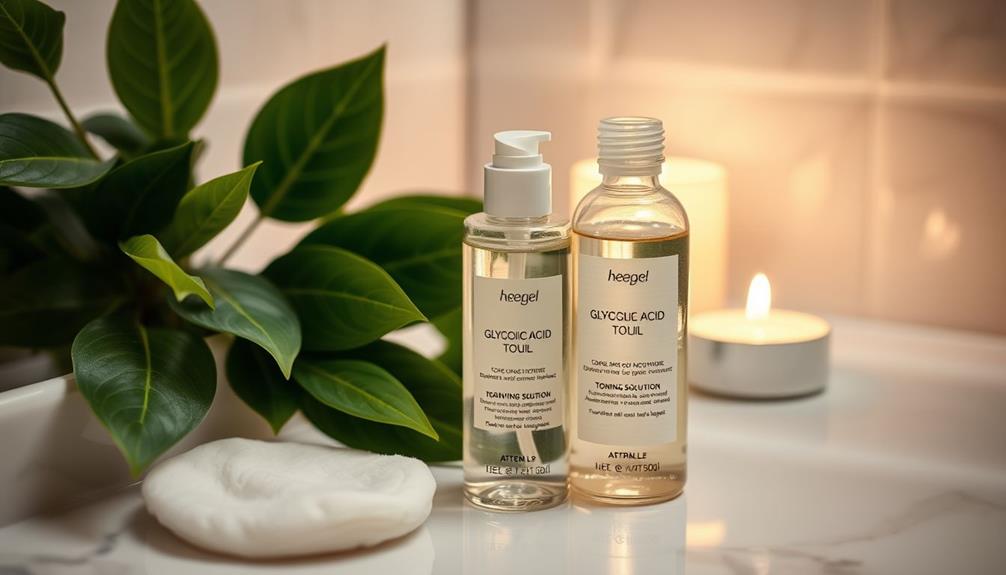Glycolic acid is a powerhouse for tackling hyperpigmentation. It exfoliates your skin, removing dead cells and promoting fresh ones, which helps fade dark spots. By increasing cell turnover and inhibiting excess melanin production, it evens out your skin tone effectively. Regular use can also boost collagen production, enhancing skin texture and elasticity. You'll likely notice improvements in clarity and radiance over time. It's crucial to start with a lower concentration and monitor how your skin reacts. Remember to pair it with sunscreen to protect your sensitive skin. There's plenty more to discover about its benefits and ideal usage.
Key Takeaways
- Glycolic acid is an AHA that promotes exfoliation, increases cell turnover, and enhances skin texture to reduce hyperpigmentation.
- It inhibits excessive melanin production, helping fade dark spots and evening out skin tone over time.
- Regular use stimulates collagen production, improving skin elasticity and clarity, resulting in a brighter complexion.
- Start with a lower concentration and gradually increase frequency to 2-4 times per week while monitoring skin response.
What Is Glycolic Acid?
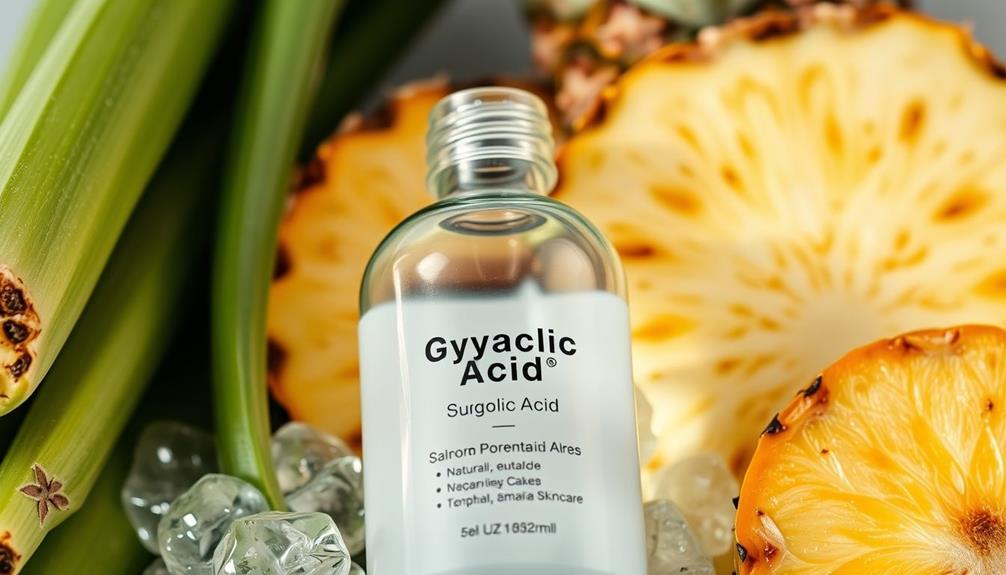
Glycolic acid, derived from natural sources like sugar cane and pineapple, is a powerful alpha hydroxy acid (AHA) that penetrates deeply into the skin to promote exfoliation and improve texture.
As a chemical exfoliant, it effectively dissolves the bonds that hold dead skin cells together, allowing for increased skin cell turnover. This process enhances your skin texture and tone, making it smoother and more radiant.
Additionally, incorporating vital oils for relaxation into your skincare routine can complement the effects of glycolic acid by promoting overall skin health and relaxation.
You'll find glycolic acid in various skincare products, such as serums, masks, and chemical peels, often with concentrations ranging from 5% to 20% for ideal results.
When incorporated into your routine, it can be particularly beneficial for treating hyperpigmentation by promoting the fading of dark spots while enhancing collagen production. This boost in collagen can help reduce the appearance of fine lines and improve skin elasticity.
However, it's crucial to remember that glycolic acid can increase your skin's sensitivity to sunlight. So, using sunscreen daily is a must to protect your skin while reaping the benefits of this powerful ingredient.
With consistent use, you can achieve a brighter, more even complexion.
Causes of Hyperpigmentation

Excess melanin production causes hyperpigmentation, leading to dark spots or patches on your skin. Several factors contribute to this condition. One of the primary culprits is sun exposure. When your skin is exposed to UV rays, it triggers the production of excess melanin, resulting in freckles and sun spots, which can make your complexion uneven.
Additionally, environmental factors, such as citrus scents that cats dislike, can also have an impact on skin health.
Another common cause is post-inflammatory hyperpigmentation (PIHP). This occurs after your skin has experienced trauma, such as cuts, acne, or treatments. Even after the initial injury has healed, dark marks can linger, creating a patchy appearance.
Hormonal changes can also play a significant role, particularly during pregnancy. This can lead to melasma, a specific type of hyperpigmentation that often appears on your face.
Additionally, environmental factors like pollution and skin irritation from ingrown hairs may exacerbate the issue, further contributing to uneven skin tone.
Understanding these causes is essential for managing hyperpigmentation effectively. By being aware of what triggers your skin, you can take steps to protect yourself and seek appropriate treatments.
Glycolic Acid's Role in Skin
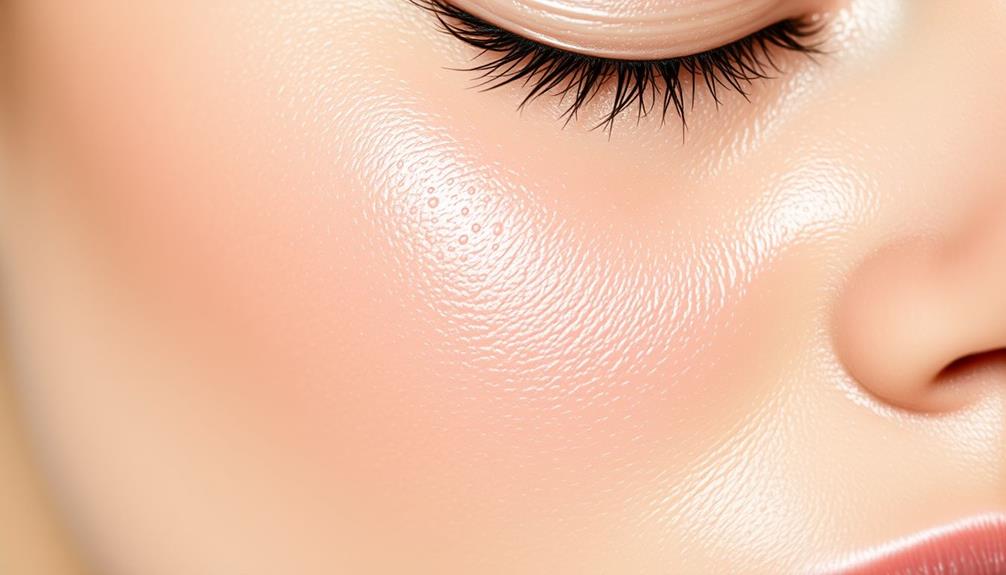
As an effective alpha hydroxy acid (AHA), glycolic acid exfoliates the skin's surface, promoting cell turnover and helping to reduce the appearance of hyperpigmentation.
This powerful ingredient works by sloughing off dead skin cells, which reveals fresh, unblemished skin underneath. You'll notice that dark spots and uneven skin tone begin to fade with regular use. Incorporating a holistic lifestyle approach can further enhance the effectiveness of glycolic acid, as it emphasizes the importance of diet and stress management for overall skin health.
Glycolic acid's small molecular size allows it to penetrate deeper layers of the skin, effectively disrupting excessive melanin production in targeted areas. This is essential for tackling hyperpigmentation, including melasma and age-related dark spots.
The exfoliating properties of glycolic acid not only enhance skin clarity but also promote a more even complexion.
Moreover, glycolic acid stimulates collagen production, which improves skin texture and elasticity, giving you a more youthful appearance.
Consistent application can lead to significant improvements, making it a go-to treatment for various types of hyperpigmentation. By incorporating glycolic acid into your skincare routine, you can achieve a smoother, brighter complexion while effectively minimizing the visibility of dark spots and enhancing your overall skin tone.
How Glycolic Acid Works
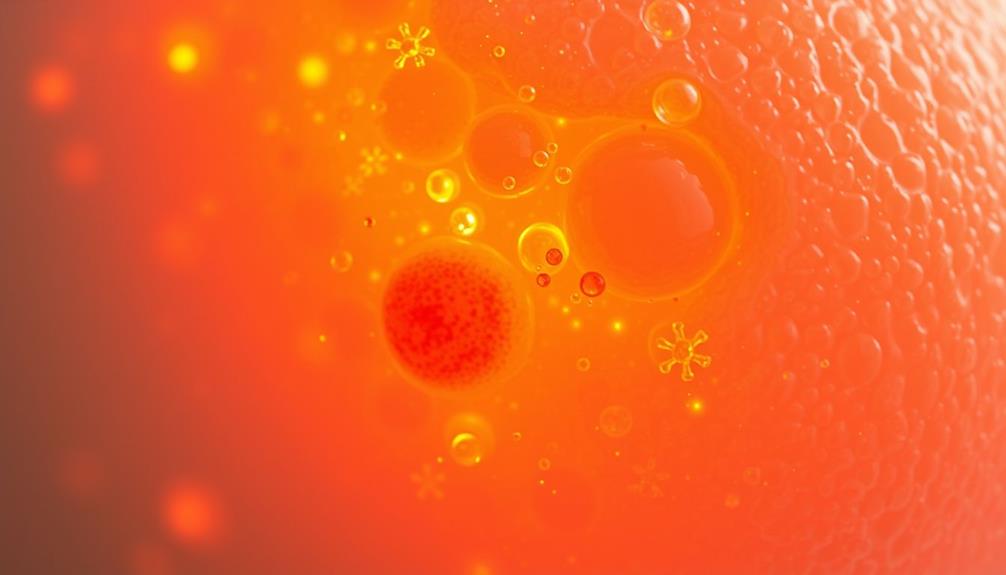
By effectively breaking down the bonds between dead skin cells, glycolic acid promotes their removal and reveals fresh, even-toned skin. As the smallest alpha hydroxy acid (AHA), glycolic acid penetrates the skin more efficiently than other exfoliants, enhancing skin turnover. This process is essential for addressing hyperpigmentation, as it encourages the shedding of old, discolored skin cells and allows new, healthier skin to surface.
Additionally, incorporating ingredients like essential oils for skin health can complement the effects of glycolic acid, as some oils possess beneficial properties for overall skin condition essential oils for specific conditions.
Glycolic acid also inhibits excessive melanin production in targeted areas, gradually reducing the appearance of dark spots. With regular application, you'll notice a more uniform skin tone, as the acid helps to diminish various types of hyperpigmentation, including melasma and post-acne marks.
Moreover, consistent use of glycolic acid stimulates collagen production, which not only improves your skin's texture but also contributes to fading dark spots over time.
Benefits for Hyperpigmentation

Glycolic acid offers a powerful solution for fading hyperpigmentation, helping you achieve a more balanced and radiant complexion. This ingredient works by exfoliating the outer layer of your skin, promoting skin turnover, and revealing fresher skin underneath.
Regular use can markedly reduce dark spots and melasma by inhibiting excess melanin production, the primary culprit behind hyperpigmentation.
Studies show that glycolic acid enhances skin clarity and reduces discoloration through its effective exfoliating properties. By sloughing off dead skin cells, it also diminishes the appearance of post-inflammatory hyperpigmentation (PIHP) caused by acne or skin irritation.
With consistent application—typically 2-4 times a week—you'll notice a more even skin tone over time.
It's essential to monitor your skin's response to avoid irritation, especially if you're new to glycolic acid.
However, the benefits are clear: with continued use, you can expect a visible improvement in the appearance of your skin, as it becomes brighter and more uniform.
Embracing glycolic acid in your skincare routine can lead to a notable reduction in hyperpigmentation, helping you enjoy a clearer, more luminous complexion.
Application Techniques

When using glycolic acid, it's vital to prepare your skin properly and follow a consistent application schedule.
You should also pay attention to post-application care to maximize its effectiveness and minimize irritation.
Let's explore the recommended frequency, ideal skin preparation, and essential aftercare tips.
Recommended Application Frequency
Starting with glycolic acid once a week allows you to gauge your skin's tolerance before gradually increasing usage to 2-4 nights per week as your skin adjusts. This approach helps you avoid irritation, which can occur if you jump in too quickly. If you notice any redness or peeling, consider limiting your application frequency to 2-3 times a week.
Incorporating glycolic acid into your skincare routine can be done through various formats like toners, serums, or masks. Generally, masks contain higher concentrations for more potent effects. It's vital to apply glycolic acid at night, as this minimizes sun sensitivity. Don't forget to use sunscreen daily; protecting your newly exfoliated skin is essential.
The key to effective treatment for hyperpigmentation is consistent use. Regular application over time will lead to noticeable improvements in your skin tone. Keep an eye on how your skin responds, and adjust your routine accordingly. Remember, it's all about finding the right balance that works for you while promoting healthier, more even skin.
Ideal Skin Preparation
Preparing your skin properly before applying glycolic acid boosts its effectiveness and minimizes potential irritation. Start by cleansing your skin thoroughly to eliminate makeup, oil, and impurities. This guarantees ideal absorption of glycolic acid. If you have sensitive skin or are new to this exfoliant, patch test a small area first to check for any adverse reactions.
Once your skin is clean, use a cotton pad to apply glycolic acid evenly across your face. This technique helps prevent patchy application and maximizes the exfoliation benefits. Remember to apply glycolic acid at night. This timing reduces sun sensitivity and allows your skin to heal overnight.
After applying glycolic acid, follow up with a nourishing moisturizer. This step soothes and hydrates your skin, further minimizing irritation.
Post-Application Care Tips
After applying glycolic acid, always follow up with a gentle, hydrating moisturizer to soothe your skin and support its barrier. This step is critical since glycolic acid can lead to dryness or irritation. Choose a moisturizer that's free from harsh ingredients to guarantee your skin feels comfortable and hydrated.
It's fundamental to incorporate sunscreen into your post-application care routine. Use a broad-spectrum sunscreen with at least SPF 30 daily, as glycolic acid increases skin sensitivity to sunlight. Protecting your skin from UV damage is essential, especially after treatments.
To minimize the risk of skin sensitivity and irritation, start with a lower concentration of glycolic acid (5-10%) and gradually increase usage as your skin adjusts. Ideally, apply it 2-3 times a week, allowing your skin to rest between applications. Overusing glycolic acid can lead to redness or peeling, so monitor your skin's response closely.
Lastly, always cleanse your skin thoroughly before applying glycolic acid to guarantee even distribution and maximum effectiveness. Using a cotton pad can help with this process, ensuring you get the best results from your treatment.
Combining With Other Ingredients
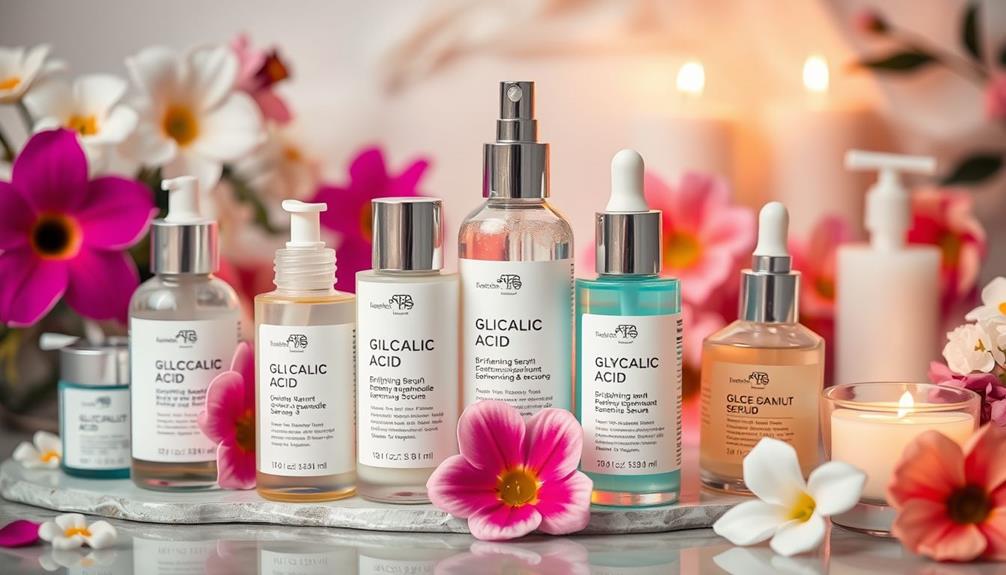
When you're using glycolic acid, it's important to know which ingredients work well together and which don't.
Pairing it with Vitamin C or hyaluronic acid can enhance your results, but you should avoid using it with retinol to prevent irritation.
Understanding these combinations can help you create a more effective skincare routine for hyperpigmentation.
Safe Ingredient Pairings
Combining glycolic acid with complementary ingredients can enhance its effectiveness while minimizing irritation.
For instance, pairing glycolic acid with lactic acid can boost exfoliation and improve your skin's texture without the irritation risks linked to using multiple AHAs.
If you have sensitive skin, consider mixing glycolic acid with niacinamide. This combination can soothe your skin and reduce potential irritation, making it a great addition to your skincare routine.
Adding antioxidants like vitamin C to your regimen can also work wonders. When you use vitamin C alongside glycolic acid, you gain extra protection against environmental stressors and enhance your skin's brightness.
To maximize the benefits of glycolic acid, apply it before your moisturizers. This allows the acid to penetrate effectively, and using ceramide-based moisturizers afterward can help maintain hydration and support your skin barrier after exfoliation.
Avoiding Irritating Combinations
Avoid skin irritation by steering clear of combining glycolic acid with other exfoliating agents like AHAs and BHAs. When you mix glycolic acid with other alpha hydroxy acids or beta hydroxy acids, you risk overwhelming your skin, leading to heightened sensitivity and irritation.
It's also important not to use glycolic acid on the same day as retinol or Vitamin A derivatives. This combination can amplify skin sensitivity and cause adverse reactions.
Instead, try alternating between glycolic acid and retinol on different days to keep your skin balanced and minimize irritation risks. For instance, you could use glycolic acid on one day and retinol the next.
Additionally, be mindful of other potential irritants in your skincare routine, such as salicylic acid. Layering these ingredients can exacerbate skin irritation, so it's best to keep them separate.
Always consult your dermatologist before integrating new active ingredients into your skincare routine. They can help tailor your regimen to your skin's specific needs and sensitivities, ensuring you achieve the best results without compromising your skin's health.
Potential Side Effects
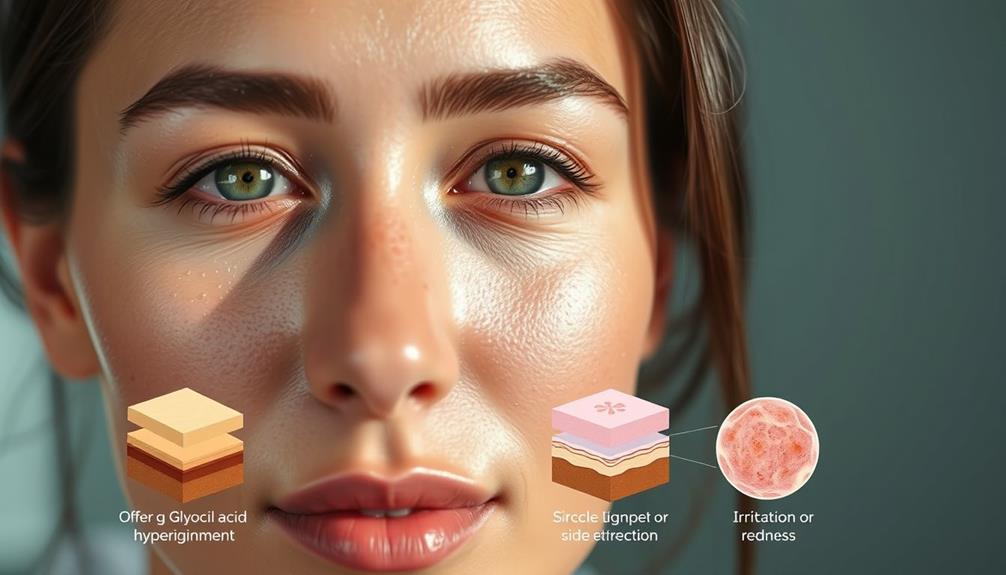
Glycolic acid can cause side effects like irritation, redness, and peeling, especially for those with sensitive skin or higher concentrations. These potential side effects can be bothersome, but knowing how to manage them can make a difference in your skincare routine.
If you have conditions like rosacea, it's vital to perform patch testing before applying glycolic acid more broadly, as it may exacerbate your symptoms.
Another important consideration is sun sensitivity. After using glycolic acid, your skin may become more susceptible to UV damage, so it's important to apply broad-spectrum sunscreen daily. This protects your skin and helps prevent further irritation or skin damage.
If you start to notice persistent irritation or discomfort, it's a sign you might be overusing glycolic acid. For beginners, it's generally best to limit usage to 2-3 times per week.
If severe irritation or an allergic reaction occurs, stop using the product immediately and consult a dermatologist for tailored advice.
Understanding these potential side effects will help you use glycolic acid effectively while minimizing risks to your skin.
Recommended Usage Tips
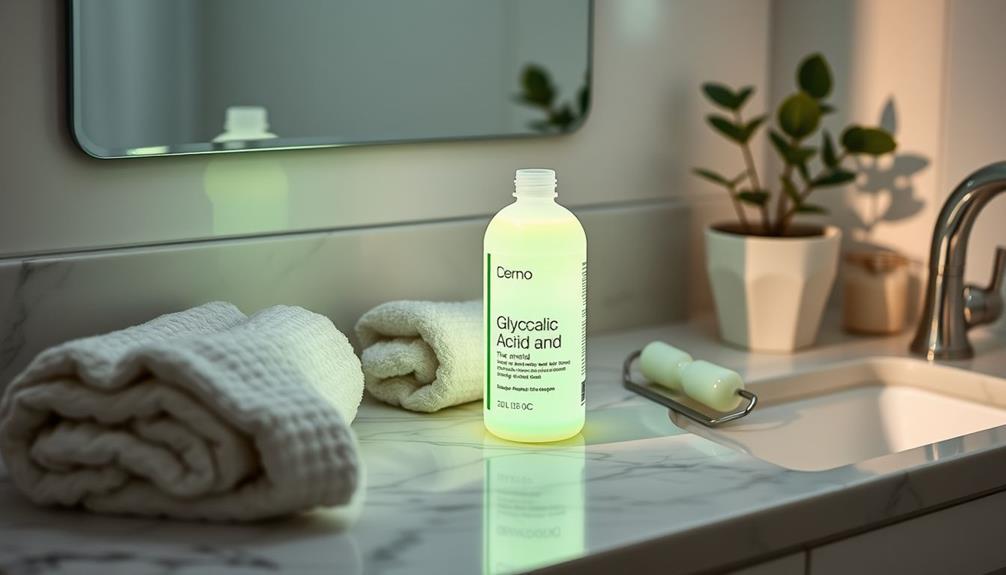
When using glycolic acid, start with a lower concentration and limit your application to once or twice a week to see how your skin reacts.
As your skin builds tolerance, you can gradually increase the frequency.
Always consider your skin type and adjust your routine accordingly to avoid irritation.
Application Frequency Guidelines
Start by applying glycolic acid 1-2 times a week to see how your skin reacts before gradually ramping up to 2-4 nights per week for the best results. Monitoring your skin's response is essential. If you notice irritation like redness or peeling, reduce usage or concentration.
Here are some tips to help you optimize your application frequency:
- Start Slow: Begin with 1-2 applications weekly to assess your skin's tolerance.
- Gradually Increase: Once your skin adjusts, aim for 2-4 nights per week for effective hyperpigmentation treatment.
- Nighttime Application: Apply glycolic acid at night to minimize sun sensitivity.
- Rest Your Skin: Always allow your skin to recover between applications to prevent irritation.
Skin Type Considerations
Understanding your skin type is essential for effectively incorporating glycolic acid into your routine and achieving the best results without causing irritation. Here's a quick guide on how to use glycolic acid based on your skin type:
| Skin Type | Recommended Concentration | Additional Tips |
|---|---|---|
| Sensitive Skin | 5-10% | Start slowly, and monitor for irritation. Use a gentle moisturizer afterward. |
| Oily/Acne-Prone | 10-15% | You can use higher concentrations more frequently to help unclog pores. |
| Dry Skin | 5-10% | Always follow with a hydrating moisturizer to maintain skin barrier integrity. |
| Combination Skin | 5-10% on dry areas, 10-15% on oily areas | Apply selectively, and watch for irritation. |
| All Skin Types | N/A | Always apply sunscreen daily to prevent hyperpigmentation, as glycolic acid increases sun sensitivity. |
Long-Term Skin Results

Using glycolic acid consistently can lead to significant long-term improvements in skin tone and texture, particularly in reducing hyperpigmentation. By incorporating it into your skincare routine, you'll notice a remarkable reduction in dark spots over time. Regular application enhances skin turnover, allowing your skin to shed excess pigment and showcase a brighter complexion.
Here are some key benefits of long-term glycolic acid use:
- Reduces dark spots: Regular use can visibly diminish hyperpigmentation and dark spots.
- Improves skin texture: The exfoliating properties lead to smoother, more refined skin.
- Stimulates collagen production: This contributes to a firmer, more youthful appearance.
- Enhances skin turnover: Faster cell renewal reveals fresher skin beneath.
You can expect to see improvements after several weeks, especially with a frequency of 2-4 applications per week. Embracing glycolic acid in your routine not only targets hyperpigmentation but also promotes overall skin health, making your complexion radiant and youthful.
Conclusion
Incorporating glycolic acid into your skincare routine can markedly reduce hyperpigmentation, with studies showing that 70% of users notice improvements within just four weeks.
By gently exfoliating and promoting cell turnover, glycolic acid helps reveal a more even skin tone.
Remember to pair it with sunscreen for the best results.
With consistent use, you'll not only see a brighter complexion but also enjoy the long-term benefits of healthier skin.
Embrace the journey to radiant skin today!
